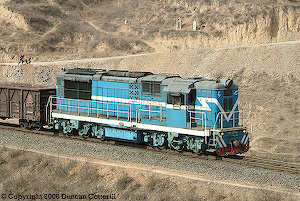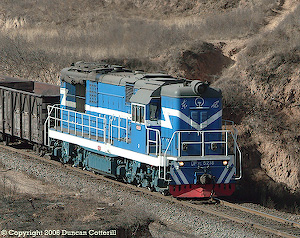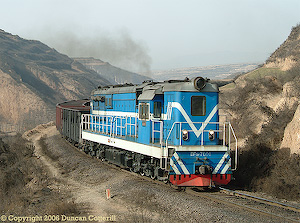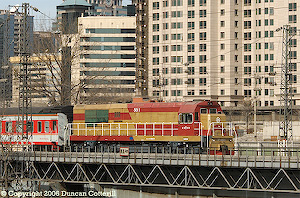DF7, DF7B, DF7C, DF7D, DF7G Class Co'-Co' Diesel-Electrics
While the DF4 and it's variants dominate main line diesel traction, the DF7 design is becoming established as the principal trip and shunt engine on the CNR system. The DF5 and DF7 are in direct competition for this sector of the market.
Like the DF4, there are a number of variations on the basic design, but all are classed DF7 and all are products of Beijing's February 7th Works.
The original DF7 was introduced in 1981 and was a 1470 kW Co-Co diesel electric hood unit powered by a downrated version of the 12 cylinder 12V240Z engine fitted to the BJ class hydraulics. These locos are easily identifiable by their not quite full height short hood and numbers in the DF7 0xxx series. Around 300 are thought to have been built, mainly for Beijing and Zhengzhou Bureaux, with a handful going directly into industrial service. They can still be found on trip and shunting duties around Beijing and across a wide area of central China extending to places like Xi'an, Baoji, Datong, Taiyuan and Wuhan. Although there is no evidence of withdrawals they may be in danger of replacement by more modern designs.
The design was updated around 1990 with a more powerful 1840 kW version of the same engine and a full height short hood. These locos were classified DF7B and numbered in the DF7 3xxx series. Unusually for a shunting loco, the DF7B came into it's own in main line service. They were used in pairs on the Shijiazuang to Zhengzhou main line to replace QJs on freights for a few years until electrification was complete. These locos then found their way into shunting service but can be recognised by their DF7 6xxx numbers. Again production ran to several hundred locos but the really big orders were still missing.
Another update occurred shortly afterwards with the adoption of the 12V240ZJ6 engine, a 12 cylinder version of the standard DF4 prime mover rated at 1470 kW. This change appeared to be what the market wanted and the DF7C gained widespread acceptance and started to sell in areas where the DF5 had previously had a monopoly. Outwardly the DF7B and DF7C are difficult to tell apart except by looking at the number. DF7C are numbered in the DF7 5xxx series. Recently the design has changed considerably with the adoption of a higher rated 1840 kW version of the same engine, followed by a low short hood then a completely new, more angular bodystyle similar to that of the DF7G on the latest machines. Approximately 700 have been built to date.
The DF7D is quite different to the rest of the DF7 line and is intended for main line service in difficult conditions. There is a mountain version designed for steep grades and tight curves and an extreme cold version designed to withstand harsh winter conditions in the far north. These locos have the same 1840 kW version of the 12V240ZJ6 as the later DF7C but sport a full width body with similar cabs to the BJ class hydraulics. Some of the mountain engines are single ended and designed to be used back-to-back in pairs. They are not in widespread use but can be found working from Mawei (Chengdu Bureau) and Jinchengjiang (Liuzhou Bureau) depots in the far south west and Bei'an and Yitulihe (Harbin Bureau) depots in the far north east.
The DF7E has a 25 ton axleload and is intended for heavy shunting service. The DF7F has a higher powered 2650 kW version of the 12V240ZJ6 engine. Neither model appears to have gone into series production.
The DF7G is the latest incarnation of the DF7 line and is a hood unit for trip and shunting work introduced in 2003. The body is of the more angular design with the low short hood that appeared on the latest DF7C locos. Power is provided by an 1840 kW 12V240ZJ6 engine. The DF7G appears to be gaining acceptance although only a few hundred have appeared to date. A number have been exported to Cuba. The DF7G has also gone into production at Sifang, the first of the line to be built anywhere apart from Feb 7th. Sifang and Beijing built locos are numbered in the DF7G 0xxx and DF7G 5xxx series respectively. There is considerable scope for confusion with later DF7C locos which have the same bodystyle and livery and DF7C 5xxx numbers.




